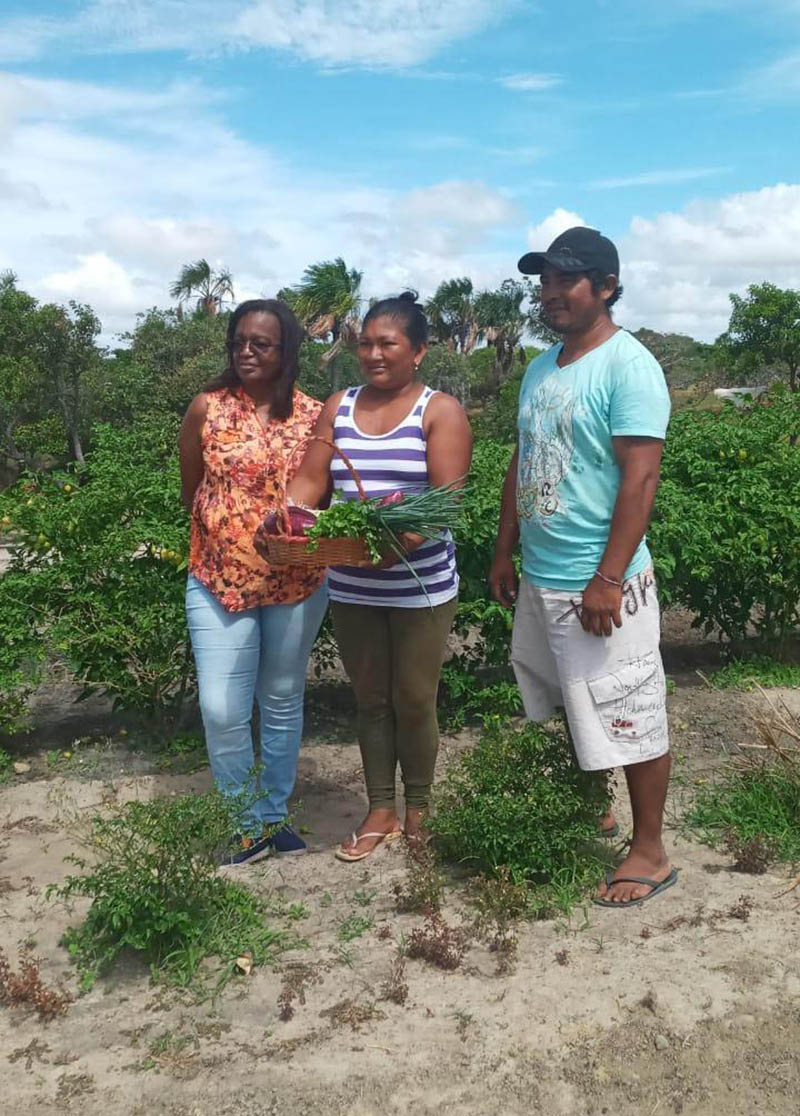The agricultural pursuits of Evelyn Daniel and her partner, Aaron Stevens, in Region Nine cry out for a measure of official support to enhance their already proven capacity to make a difference to residents of St. Ignatius. Indeed, what it does, is to make the point that there is a case to be made for structured interventions from central government that could impact food security in Region Nine communities and perhaps even create markets outside of the region that would boost the economies of some of the depressed areas in the region.
The couple’s eschallot farm, located on a plot of land contiguous to their home, has been making an eye-catching contribution to increasing the availability of the commodity in communities like Quarrie, Kumu, and Moco Moco in Region Nine. Sustaining, and over time, expanding the couple’s eschallot cultivation pursuits continues to be negatively impacted by a scarcity of resources and according to Aaron, a little help can go a long way in positioning the couple to do even more for the communities that they currently serve. It is an appeal to which government would do well to listen.
On Saturday November 27, towards the ‘back end’ of the Stabroek Business’ recent visit to Lethem, we encountered Evelyn and Aaron at a Community Market Day. The couple, with their eye-catching bundles of eschallot being offered for sale at the event, were, unquestionably the standout vendors. Indeed. Our encounter with Evelyn, laden down with numerous bundles of the attractive-looking green seasoning, eventually became reduced to a friendly wager as to how many bundles she was likely to sell by the end of the trading day.
There are few more appealing sights in this country of ours than attractively presented bundles of farm produce and when we spoke with Evelyn she was gushing with confidence that by the end of the trading day her eschallot would be sold out. As it turned out, she was left with a mere twenty bundles when the day’s trading came to a close, a small amount given the fact that she had begun the day with around 300 bundles. And that, by her reckoning, meant that she had had a satisfying trading day.
The success of their eschallot initiative has meant that Evelyn and Aaron now make a noteworthy contribution to increasing the availability of what we are told is a sought-after commodity in numerous kitchens in the region. Indeed, as far as the Stabroek Business has discerned, the couple’s eschallot cultivation pursuits has led to a reduction in the volumes of the commodity imported from neighbouring Brazil these days.
Periodic weather-related challenges and less-than-adequate overall support for agriculture in the region, have meant that the couple have had to ‘dig deep’ to keep their farming pursuit going. Their eschallot output has grown to a point where they now supply supermarkets and shops in Lethem. Households at St Ignatius have ‘standing order’ arrangements with the couple while potential buyers visit the farm to watch their eschallot reaped and bundled.
The couple’s eschallot ‘enterprise’ has grown to a point where Aaron is aiming to upgrade his delivery service by acquiring a motorcycle though he concedes that such an acquisition is not affordable at this time. Setting aside their regular customers, the couple rely on the St Ignatius monthly Market Day which affords periodic windfalls that keep the business ‘ticking over.’
Evelyn and Aaron returned to Guyana from Brazil earlier this year. They had lived and worked there for more than ten years. Upon their return Evelyn had secured a job with a supermarket in Lethem. Much of her earnings had been invested in land-clearing and cultivation pursuits. Among the items that the couple acquired were seedlings, a cutlass, a pickaxe, pipes with which to create a drip irrigation system and fuel for their generator. A nearby canal was pressed into service for irrigation.
Cultivation began with trial and error. Pepper, boulanger, bora, okra, tomato, watermelon, and eschallot, were all tried, in turn. After four months they agreed that the soil was best suited to eschallot. That apart, the couple’s ‘market survey’ suggested that eschallot was the likely best money-earner.
A visit to the couple’s farm is more than sufficient to discern that they now manage an impressive ‘spread’ though meaningful consolidation continues to be hampered by a lack of resources. Their immediate goal is to replace the cutlass and pickaxe, the present tools of the trade, with a hand plough and tiller, tools which they say would make their pursuit less physically stressful.
Aaron’s day begins at the crack of dawn. Days are set aside for harvesting and delivery to customers. Others are dedicated to ‘tidying up,’ removing weeds and creating additional beds. When there is major harvesting to be done, Aaron would recruit a few persons from the community to work with him.
The nature of eschallot, Aaron says, is such that it does not thrive in inclement weather. Accordingly, he has grown accustomed to having to be prepared to absorb what, sometimes, are considerable losses when the rains come. It will, however, take a great deal more than that to cause the couple to give up on a venture from which they say they are seeing returns, the remaining stumbling blocks notwithstanding.






